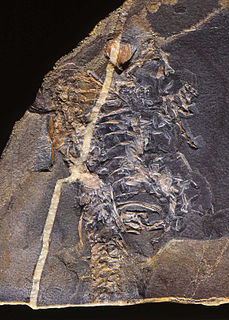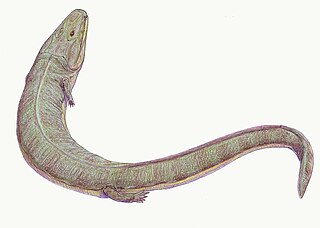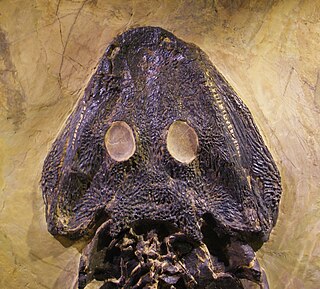
Amniotes are a clade of tetrapod vertebrates that comprise sauropsids and synapsids. They are distinguished by a membrane (amnion) protecting the embryo and a lack of a larval stage. Thanks to this, amniotes lay eggs on land or retain them within the mother, unlike anamniotes, which typically lay eggs in water. Older sources, particularly before the 20th century, may refer to amniotes as "higher vertebrates" and anamniotes as "lower vertebrates", based on the antiquated idea of the evolutionary great chain of being. The term amniote comes from the Greek ἀμνίον amnion, "membrane surrounding the fetus", and earlier "bowl in which the blood of sacrificed animals was caught", from ἀμνός amnos, "lamb".

Labyrinthodontia is an extinct amphibian subclass, which constituted some of the dominant animals of late Paleozoic and early Mesozoic eras. The group evolved from lobe-finned fishes in the Devonian and is ancestral to all extant landliving vertebrates. As such it constitutes an evolutionary grade rather than a natural group (clade). The name describes the pattern of infolding of the dentin and enamel of the teeth, which are often the only part of the creatures that fossilize. They are also distinguished by a heavily armoured skull roof, and complex vertebrae, the structure of which were used in older classifications of the group.

Batrachomorpha is a name traditionally given to recent and extinct amphibians that are more closely related to modern amphibians than they are to reptiles. It most often includes the extinct groups Temnospondyli and Lepospondyli. The first tetrapods were all amphibians in the physiological sense that they laid their eggs in water, and are colloquially sometimes referred to as labyrinthodonts or stegocephalians. In this scheme, batrachomorphs composed one branch of these early amphibians, while the reptiliomorphs composed the other. While the actual phylogeny of the modern amphibians is not well understood, their ancestors are descended from one line of batrachomorphs. All other living tetrapods are descended from one branch of reptiliomorphs, the amniotes. Amniotes achieved dominance, while all other reptiliomorphs and most batrachomorphs have gone extinct.

Lepospondyli is a diverse taxon of early tetrapods. With the exception of one late-surviving lepospondyl from the Late Permian of Morocco, lepospondyls lived from the Early Carboniferous (Mississippian) to the Early Permian and were geographically restricted to what is now Europe and North America. Five major groups of lepospondyls are known: Adelospondyli; Aïstopoda; Lysorophia; Microsauria; and Nectridea. Lepospondyls have a diverse range of body forms and include species with newt-like, eel- or snake-like, and lizard-like forms. Various species were aquatic, semiaquatic, or terrestrial. None were large, and they are assumed to have lived in specialized ecological niches not taken by the more numerous temnospondyl amphibians that coexisted with them in the Paleozoic. Lepospondyli was named in 1888 by Karl Alfred von Zittel, who coined the name to include some tetrapods from the Paleozoic, that shared some specific characteristics in the notochord and teeth. Lepospondyls have sometimes been considered to be either related or ancestral to modern amphibians or to Amniota. It has been suggested that the grouping is polyphyletic, with aïstopods being primitive stem-tetrapods, while microsaurs are primitive reptiles.

Reptiliomorpha is a clade containing the amniotes and those tetrapods that share a more recent common ancestor with amniotes than with living amphibians (lissamphibians). It was defined by Michel Laurin (2001) and Vallin and Laurin (2004) as the largest clade that includes Homo sapiens, but not Ascaphus truei.

Anthracosauria is an order of extinct reptile-like amphibians that flourished during the Carboniferous and early Permian periods, although precisely which species are included depends on one's definition of the taxon. "Anthracosauria" is sometimes used to refer to all tetrapods more closely related to amniotes such as reptiles, mammals, and birds, than to lissamphibians such as frogs and salamanders. An equivalent term to this definition would be Reptiliomorpha. Anthracosauria has also been used to refer to a smaller group of large, crocodilian-like aquatic tetrapods also known as embolomeres.

Diadectes is an extinct genus of large reptiliomorphs or synapsids that lived during the early Permian period. Diadectes was one of the first herbivorous tetrapods, and also one of the first fully terrestrial animals to attain large size.

Diadectomorpha are a clade of large tetrapods that lived in Euramerica during the Carboniferous and Early Permian periods and in Asia during Late Permian (Wuchiapingian), They have typically been classified as advanced reptiliomorphs close to the ancestry of the Amniota, though some paleontologists consider them basal synapsids. They include both large carnivorous and even larger herbivorous forms, some semi-aquatic and others fully terrestrial. The Diadectomorpha seem to have evolved during late Mississippian times, although they only became common after the Carboniferous rainforest collapse and flourished during the Late Pennsylvanian and Early Permian periods.

Temnospondyli is a diverse order of small to giant tetrapods—often considered primitive amphibians—that flourished worldwide during the Carboniferous, Permian, and Triassic periods. A few species continued into the Jurassic and Cretaceous periods. Fossils have been found on every continent. During about 210 million years of evolutionary history, they adapted to a wide range of habitats, including fresh water, terrestrial, and even coastal marine environments. Their life history is well understood, with fossils known from the larval stage, metamorphosis, and maturity. Most temnospondyls were semiaquatic, although some were almost fully terrestrial, returning to the water only to breed. These temnospondyls were some of the first vertebrates fully adapted to life on land. Although temnospondyls are considered amphibians, many had characteristics, such as scales, claws, and armour-like bony plates, that distinguish them from modern amphibians.

Seymouria is an extinct genus of Seymouriamorph from the Early Permian of North America and Europe. Although they were amphibians, Seymouria were well-adapted to life on land, with many reptilian features—so many, in fact, that Seymouria was first thought to be a primitive reptile. It is primarily known from two species, Seymouria baylorensis and Seymouria sanjuanensis. The type species, S. baylorensis, is more robust and specialized, though its fossils have only been found in Texas. On the other hand, Seymouria sanjuanensis is more abundant and widespread. This smaller species is known from multiple well-preserved fossils, including a block of six skeletons found in the Cutler Formation of New Mexico, and a pair of fully grown skeletons from the Tambach Formation of Germany, which were fossilized lying next to each other.

Westlothiana is a genus of reptile-like tetrapod that lived about 338 million years ago during the latest part of the Visean age of the Carboniferous. Members of the genus bore a superficial resemblance to modern-day lizards. The genus is known from a single species, Westlothiana lizziae. The type specimen was discovered in the East Kirkton Limestone at the East Kirkton Quarry, West Lothian, Scotland in 1984. This specimen was nicknamed "Lizzie the lizard" by fossil hunter Stan Wood, and this name was quickly adopted by other paleontologists and the press. When the specimen was formally named in 1990, it was given the specific name "lizziae" in homage to this nickname. However, despite its similar body shape, Westlothiana is not considered a true lizard. Westlothiana's anatomy contained a mixture of both "labyrinthodont" and reptilian features, and was originally regarded as the oldest known reptile or amniote. However, updated studies have shown that this identification is not entirely accurate. Instead of being one of the first amniotes, Westlothiana was rather a close relative of Amniota. As a result, most paleontologists since the original description place the genus within the group Reptiliomorpha, among other amniote relatives such as diadectomorphs and seymouriamorphs. Later analyses usually place the genus as the earliest diverging member of Lepospondyli, a collection of unusual tetrapods which may be close to amniotes or lissamphibians, or potentially both at the same time.

Casineria is an extinct genus of tetrapod which lived about 340-334 million years ago in the Mississippian epoch of the Carboniferous period. Its generic name, Casineria, is a latinization of Cheese Bay, the site near Edinburgh, Scotland where the holotype fossil was found. When originally described in 1999, it was identified as a transitional fossil noted for its mix of basal (amphibian-like) and advanced (reptile-like) characteristics, putting it at or very near the origin of the amniotes, the group containing all mammals, birds, modern reptiles, and other descendants of their reptile-like common ancestor. However, the sole known fossil is lacking key elements such as a skull, making exact analysis difficult. As a result, the classification of Casineria has been more controversial in analyses conducted since 1999. Other proposed affinities include a placement among the lepospondyls, seymouriamorphs, "gephyrostegids", or as a synonym of Caerorhachis, another controversial tetrapod which may have been an early temnospondyl.

Eucritta is an extinct genus of stem-tetrapod from the Viséan epoch in the Carboniferous period of Scotland. The name of the type and only species, E. melanolimnetes is a homage to the 1954 horror film Creature from the Black Lagoon.

Tulerpeton is an extinct genus of Devonian four-limbed vertebrate, known from a fossil that was found in the Tula Region of Russia at a site named Andreyevka. This genus and the closely related Acanthostega and Ichthyostega represent the earliest tetrapods.

Embolomeri is an order of tetrapods or stem-tetrapods, possibly members of Reptiliomorpha. Embolomeres first evolved in the Early Carboniferous (Mississippian) Period and were the largest and most successful predatory tetrapods of the Late Carboniferous (Pennsylvanian) Period. They were specialized semiaquatic predators with long bodies for eel-like undulatory swimming. Embolomeres are characterized by their vertebral centra, which are formed by two cylindrical segments, the pleurocentrum at the rear and intercentrum at the front. These segments are equal in size. Most other tetrapods have pleurocentra and intercentra which are drastically different in size and shape.

Gephyrostegus is an extinct genus of gephyrostegid reptiliomorph amphibian. It was a small animal, 22 cm in total length, of generally lizard-like build and presumably habit. It had large eyes and a large number of small, pointed teeth, indicating it was an active insectivorous hunter. The remains have been found in Nýřany, Czech Republic, dating from around 310 million years ago.

Colosteidae is a family of stegocephalians that lived in the Carboniferous period. They possessed a variety of characteristics from different tetrapod or stem-tetrapod groups, which made them historically difficult to classify. They are now considered to be part of a lineage intermediate between the earliest Devonian terrestrial vertebrates, and the different groups ancestral to all modern tetrapods, such as temnospondyls and reptiliomorphs.

Acherontiscus is an extinct genus of stegocephalians that lived in the Early Carboniferous of Scotland. The type and only species is Acherontiscus caledoniae, named by paleontologist Robert Carroll in 1969. Members of this genus have an unusual combination of features which makes their placement within amphibian-grade tetrapods uncertain. They possess multi-bone vertebrae similar to those of embolomeres, but also a skull similar to lepospondyls. The only known specimen of Acherontiscus possessed an elongated body similar to that of a snake or eel. No limbs were preserved, and evidence for their presence in close relatives of Acherontiscus is dubious at best. Phylogenetic analyses created by Marcello Ruta and other paleontologists in the 2000s indicate that Acherontiscus is part of Adelospondyli, closely related to other snake-like animals such as Adelogyrinus and Dolichopareias. Adelospondyls are traditionally placed within the group Lepospondyli due to their fused vertebrae. Some analyses published since 2007 have argued that adelospondyls such as Acherontiscus may not actually be lepospondyls, instead being close relatives or members of the family Colosteidae. This would indicate that they evolved prior to the split between the tetrapod lineage that leads to reptiles (Reptiliomorpha) and the one that leads to modern amphibians (Batrachomorpha). Members of this genus were probably aquatic animals that were able to swim using snake-like movements.

The Stem Tetrapoda are a cladistically defined group, consisting of all animals more closely related to extant four-legged vertebrates than to their closest extant relatives, but excluding the crown group Tetrapoda. They are thus paraphyletic, though acceptable in phylogenetic nomenclature as the group is defined by strict reference to phylogeny rather than to traits as in traditional systematics. Thus, some finned sarcopterygians are considered to be stem tetrapods.

Otic notches are invaginations in the posterior margin of the skull roof, one behind each orbit. Otic notches are one of the features lost in the evolution of amniotes from their tetrapod ancestors.

























